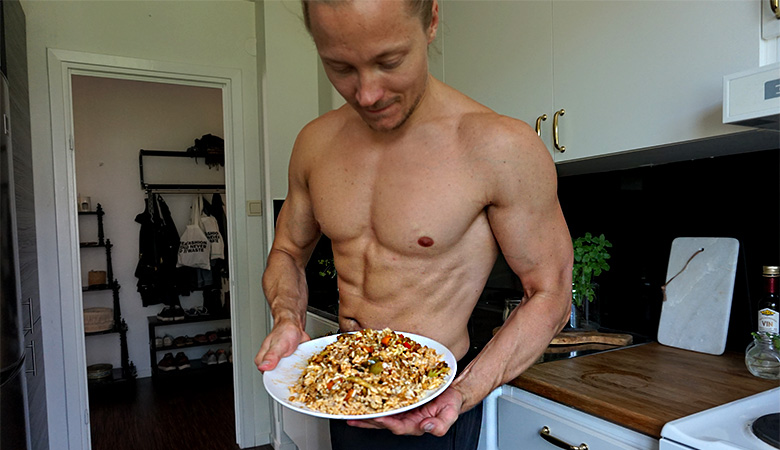
One of the biggest challenges people face when they start cutting with the goal to achieve a lean and chiseled body is; hunger…
Hunger is one of the biggest reason why people fail to follow through on their fat loss goals, next to restrictiveness.
You see, for fat loss to occur you must be in a prolonged calorie deficit where you consistently burn more calories than you consume. This is known as the law of thermodynamics and it is a fundamental principle that any fat loss program must be based around.
When you take in fewer calories than what your body burn, it must turn to its stored energy (body fat) to make up for the missing energy that its not getting from the diet.
Table of Contents
Is it Even Possible to Avoid Hunger While Cutting?
When you are in a prolonged calorie deficit required for fat loss you will inevitably experience some hunger, that’s simply the name of the game! I always embrace the hunger I’m feeling. I know that if I feel a bit of hunger then I’m on the right track.
But, hunger shouldn’t be so high that it becomes unsustainable to lose body fat. No, you should do your best to minimize your hunger, because the less hunger you can feel and the more you can enjoy your fat loss the better results you will get!
So, by implementing the following 20 strategies that I’ve outlined below you will be equipped with the best possible hunger and appetite reducing strategies to successfully get that shredded physique.
1. Be in a Small to Moderate Calorie Deficit
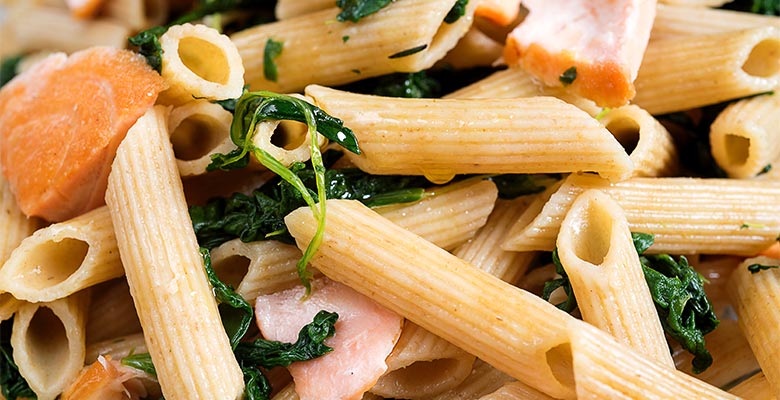
This is the most important strategy in the entire list. How large you decide to set your calorie deficit affects your results more than everything. If you eat too few calories you will experience a ton of hunger even if you were to follow every other strategy in this list to a T.
Not only will you experience a ton of hunger if you’re in a large calorie deficit, you will also lose an excessive amount of lean muscle mass throughout your cut as well.
I recommend that you always think of fat loss as a marathon and not a sprint. You do this by setting up just a small to moderate calorie deficit where you will gradually melt your fat away while allowing you to retain your hard earned muscle mass and also keep your hunger under control in the meantime.
A good guideline for this is to set up a calorie deficit that’s around 15-20% below your maintenance calories, where you aim to lose 1-2 lbs of fat per week tops. If you want to learn more about setting up an optimal calorie deficit, I recommend reading this post next.
2. Eat Enough Protein
Research has clearly shown that protein is our most satiating and filling macronutrient. Simply said, keeping a high protein intake helps reduce hunger. Not only that, protein also plays an important role in helping you preserve your lean muscle mass as you cut down to a lower body fat.
Now, for optimal satiety it’s important that you don’t go overboard with your protein intake either. A lot of people recommend that you eat sky high intakes of protein while cutting. But I’ve actually found this to counterproductive.
The reason why it’s counterproductive with a very high protein intake is because your carb and fat intake must come down for you to still remain in a calorie deficit. And I’ve found that with a very low carb and fat intake your enjoyment and well-being goes out the window. And when that happens you actually experience more hunger just out of boredom and dissatisfaction.
So, the protein intake that I recommend is right around 1.8 g per kg (0.8 g per lb) of body weight per day. You can read more about the benefits of having a slightly lower protein intake than what’s usually recommended when cutting here.
3. Eat Fiber-Rich Foods
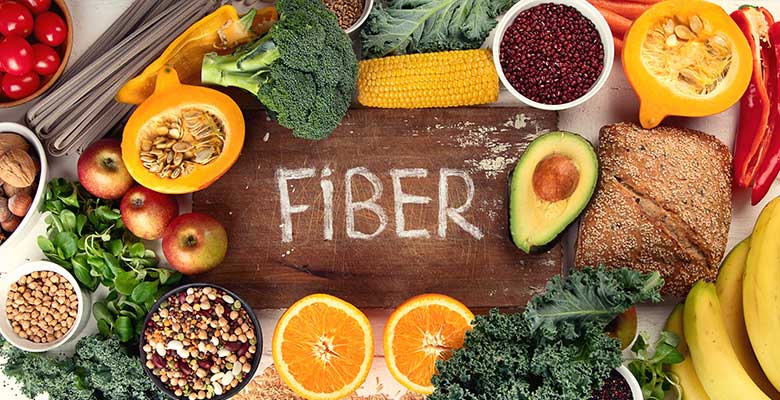
A high fiber intake helps reduce hunger by stretching the stomach, slowing down its emptying rate and promotes the release of various fullness hormones.
Not only that, fiber can ferment in the stomach. This fermentation process produces short-chain fatty acids that has been shown to further cause feelings of fullness.
You can easily increase your fiber intake by eating fibrous vegetables and fruits, as well as high fiber foods such as potatoes, whole grains, oatmeal, barley, nuts and seeds.
A good fiber recommendation is to consume 15 grams of fiber for every 1000 kcal you eat.
Here’s a tidy chart created by Jamie Miller from UK Fitness Personal Training:
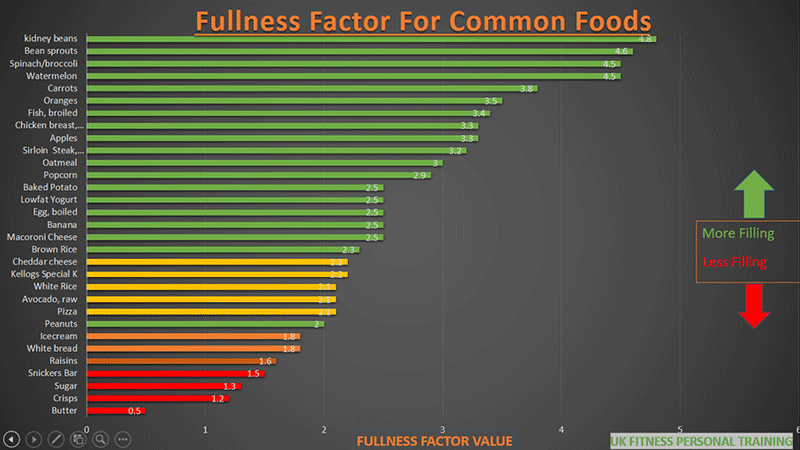
4. Go Solid Avoid Liquid
It’s well known that liquid calories are far less filling than solid calories.
In this study, researchers split participants into two different groups. One group ate a semi-solid snack and the other group had a liquid snack. The participants who had a semi-solid snack reported less hunger, a lower desire to eat and a greater feeling of fullness than the participants who had a liquid snack.
It’s just common sense that liquid calories will fill the stomach less than solid calories. So even if the calorie content is higher in a liquid foods, it will still satiate far less than solid foods.
5. Consume a Balanced Intake of Macros
This point ties together with what I discussed earlier about not going too high in protein.
In order to achieve optimal satiety and satisfaction from your diet while cutting, then you should avoid going low in either fats or carbs (which is very common in the dieting world).
The problem with going low in fats and carbs
The reason why going too low in either fats or carbs are problematic is that both are required for optimal satiety and well-being.
For instance, when you go very low in carbs (under 20-30% of total calories per day), bad things start to take place. Sufficient amount of carbs support training performance, testosterone levels, reduce stress and improve mood through the release of the neurotransmitters serotonin and tryptophan. With low levels of these neurotransmitters you won’t be able to feel as relaxed and happy as you normally would with higher levels. Also, your sleep quality could likely be reduced as well.
When you go very low in fat (under 20% of total calories per day), you impair hormonal functioning, you make food taste boring and you will make it really hard to remain full since adequate fat helps with satiation.
So basically, if you want to feel your best and reduce hunger as you cut down to a low body fat percentage try to consume only adequate amounts of protein and enjoy a balanced intake of fats and carbs.
Remember, this can be achieved with a range of macro intakes. There’s no need to stick to a specific macro number like 40-40-20 or something like that. Just make sure that you stick within your calories and eat adequate protein, once that’s covered let your carbs and fats simply end up where they do depending on what you decide to eat for the day.
6. Learn to Eat Fewer But Bigger Meals
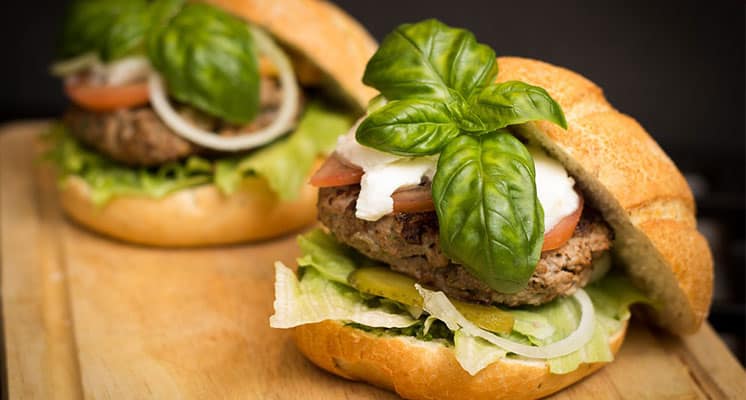
After calories, macros and fiber-rich foods are in check learning to eat fewer but bigger meals is definitely the best thing you can do to reduce hunger!
In my opinion eating huge satiating meals is the holy grail for effortless fat loss. If you truly want to reduce your hunger when cutting I recommend that you avoid the typical dogma of eating 4-6 smaller meals per day every 3-4 hours. Not only is this propagation based on zero research, it’s also what makes fat loss so freaking hard.
I learned this the hard way by trying to eat 6 meals per day every 3 hours, this way of eating had me feeling hungry constantly. It wasn’t until I started to follow Radu’s advice in The ShredSmart Program that I started to feel like a million bucks during my cutting phases.
What helped me the most with my hunger was when I started to do intermittent fasting which I still do to this day. I fast for 4-6 hours in the morning, I then have 2 large meals, the first one at mid day and the second one in the evening. I usually go with a small snack either between the two meals or after the last meal.
This allow me to indulge in large meals (~1000 kcal per meal), that not only blunt my hunger for multiple hours all while I drop body fat in the meantime. But also allow me to live a normal life where I can spend time around the dinner table with my friends and family without having to say no to food. Or go out drinking alcohol without thinking that I’m ruining my diet. Intermittent fasting equals freedom in my opinion which is why I like it so much.
If you want to learn more about the power that intermittent fasting has when it comes to increasing satiety and enjoyment to the diet, read this post next.
What about during the fast?
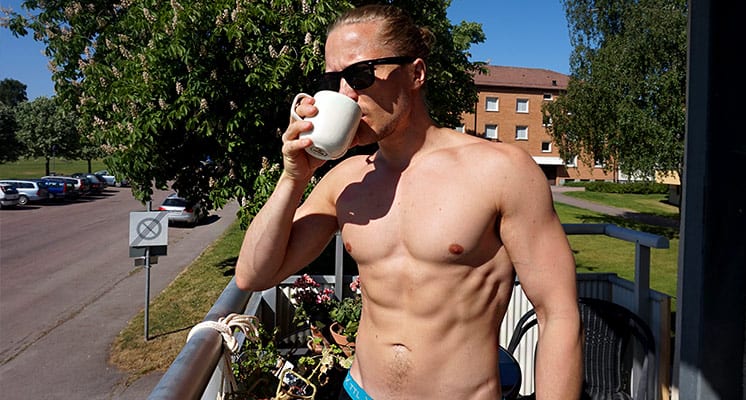
People who’ve never tried intermittent fasting are worried that they will be hungry during the fast. But I’ve found the opposite to be true.
By now I’ve coached a lot of people who have decided to give intermittent fasting a try. The only time that I’ve noticed people feeling hungry when fasting is in the beginning, before they get used to fasting. This period lasts for about 1-4 weeks (very individual). The reason why most people feel hungry during the morning as they just start to use IF is because they are used to eating breakfast and/or a late morning snack. Research has shown that our hunger hormones work on a clock that is adapted to our current eating pattern. So, if you stop eating when you are used to, you will feel hunger, until of course you get used to your new eating pattern.
Once you have been through the initial 1-4 weeks you will notice that fasting has the opposite effect, that it actually blunts hunger, especially with the help of the following tricks:
- Drinking a lot of water during the fast
- Drinking 1-2 cups of coffee during the fast
- Eating or drinking sugar free stuff during the fast
- Moving around or staying physically active during the fast
- Eating a fruit (will break fast, but only with very few calories)
- Sleeping enough during the night before the fast
- Using a flexible fasting schedule
If you want to learn more about these intermittent fasting tricks you can check out this post.
7. Consume Foods That Keep You Both Full And Satisfied
When it comes to reducing hunger and feeling happy on a diet I’ve found that going all out clean eating is not a good approach in the long-term.
Sure by eating mostly wholesome nutrient dense foods that are high in fiber, the fullness factor is at its highest. But, if I can’t have any tasty stuff occasionally when I want to I become miserable and actually feel more hungry simply from those negative feelings.
This is why I always make room for some enjoyable stuff in my diet when I’m cutting. In my opinion life sucks if all I’m working towards is a shredded physique at the cost of an enjoyable life. I believe that getting the physique should add value to my life by giving more than it takes.
The 80/20 rule of dieting
To make sure I’m eating things that are both healthy and satiating, but yet at the same time allowing myself to eat some enjoyable stuff as well, I like to follow the 80/20 rule of dieting.
This is where 80% of my diet is made up of wholesome nutrient dense foods and then once I have that covered the remaining 20% can be from whatever foods I like. So, if I’m eating let’s say 20 meals per week, then 4 of these meals can be whatever I feel like as long as I control the intake and not overindulge.
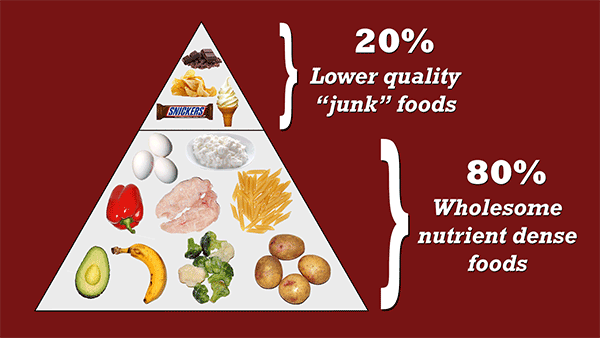
8. Train With Lower Volume in The Gym
Training volume is simply the amount of training you do in the gym. What a lot of people don’t know is that a high amount of training volume can significantly increase appetite.
This can make dieting a grueling experience, and to what point? High volume training is often unnecessary for everyone except top level athletes who have been training for decades.
What builds a great physique is being in a well set up calorie deficit that you can stick to in the long-term in order to reach a low body fat percentage, while progressing your strength on a few key exercises in the meantime.
All you need to do to successfully build a sexy physique is training 3 times per week for 45 minutes focusing on intensity and on getting stronger. You don’t need 20 sets per muscle group per week to build a strong and sexy looking physique. Stick to 5-10 sets per muscle group per week and you will feel better and experience a lot better results.
If you want to learn more about the power of minimalistic training, read this post next.
9. Don’t Overdo Your Cardio
This ties together with the previous point. The more training you do the more you will increase your appetite. In fact, hunger grows disproportionately with training volume, meaning most people will feel the urge to compensate with more food than what the training they did actually burned.
For this reason you should be very careful with the amount and type of cardio you do. You should let your diet take care of the majority of your calorie deficit. Then if you feel that you’re eating too little, then you can mix in some cardio to help you burn a bit more calories.
The type of cardio that stimulates the least amount of hunger is high intensity and short duration cardio, such as HIIT. So if you feel the need to do cardio, implement a couple of HIIT sessions per week lasting around 15-20 minutes each.
If you want to learn more about what type, when and how you should think about your cardio when cutting, check out this post.
10. Listen to Your Body (The Fat Loss Paradox)

When I was going through The ShredSmart Program I learned about something called the fat loss paradox.
The fat loss paradox implies that in order to become lean you must focus on being in a calorie deficit and hitting your macros (mainly protein). But in order to feel good and actually reduce your hunger feelings you must also do something that most people neglect completely, which is listening to your body by allowing your hunger and instincts to guide you.
When you combine these two skills (controlling your diet and listening to your body) that’s when you’re able to not only get to a low body fat percentage, but also maintain it.
Now listening to your body is very much an individual thing to do, which is why it’s hard to give any concrete recommendations of what to do. But, essentially what you should do is the following:
1. Learn to be flexible with your calorie intake
For me personally and for a lot of people that I’ve helped get lean, being flexible by setting up a bigger span of daily calories to hit is a very helpful strategy for making fat loss more easy and enjoyable.
For instance, if you are supposed to lose 1 lb of body weight per week and you theoretically will do so by eating let’s say 2000 kcal per day. Then allow yourself to eat between 1700 and 2300 kcal per day depending on how you feel on that specific day. If you feel very hungry on one day, then listen to your body and eat 2300 kcal that day.
By doing this I almost always notice that people feel less hungry during the next couple of days, and feel satisfied eating only around 1700 or 1800 kcal on those days. The worst thing you can do is getting so fixated on eating a strict number of calories each day. I’ve tried this and it only leads to hunger, frustration and anxiety because I go against my body’s natural impulses.
2. Learn to be patient
This goes back to the first point in this list, which is keeping a small to moderate calorie deficit.
Here’s the deal:
The more patient you can be with your fat loss and the more you can enjoy the actual process of working out and building a sustainable lifestyle around creating a lean and muscular body, the less hunger and the better you will feel.
Being able to use only a small calorie deficit requires patience. And how do you build patience?
You build patience by embracing that your results will be better and more sustainable if you are patient. But more importantly, you will also become patient automatically if you accept fitness as your lifestyle and who you are right now instead of a distant goal you’re trying to reach.
11. Drink Plenty of Water
From a deep strategy of listening to your body to a more upfront one is drinking plenty of water.
Drinking enough water has been shown to have a huge impact on fullness. For instance, in this study they found that people who drink two glasses of water right before having a meal eat 22% less than those who didn’t drink any water.
Not only that, drinking enough water during the fasted hours also help with fullness. This is likely because consuming water in quantities above 500 ml (17 oz) has been shown to stretch the stomach enough to send signals of fullness to the brain.
12. Sleep Enough Each Night

Good sleep quantity and quality helps reduce hunger and keep you full longer.
For instance this study showed that people who sleep less than seven hours per night score their level of fullness after their meals to be 26% lower than if they slept more than seven hours.
Not only that other studies who that poor sleep can increase hunger by up to 24%, and decrease the levels of various fullness hormones by up to 26%
Lastly, it’s been shown that poor sleep during a calorie restricted diet (i.e during a cut), leads to a higher degree of muscle loss as opposed to fat loss. This holds true even though all other factors such as calorie intake, protein intake and resistance training are in place.
So not only is adequate sleep important for reducing hunger, but it’s also very important if you want to keep as much muscle as possible during your fat loss phase.
13. Slow Down Your Eating
This is a pretty straight forward one, but research has shown that eating your meals slowly, by chewing your food at least 20 times before swallowing and preferably putting down the fork or spoon for a few seconds between bites of food, helps you feel fuller and more satiated off of a smaller amount of food.
Your food won’t run away from you so there’s no need to stress your food down, which leads us to the next point:
14. Reduce Stress
Excessive stress is known to raise our levels of the stress hormone cortisol.
For most people, not all though, high cortisol levels often leads to food cravings and the drive to eat more food.
Not only that, stress may also reduce the levels of a peptide called YY (PYY), which is a fullness promoting hormone.
When you’re in a calorie deficit trying to lose body fat you’ve already placed yourself in a situation where your stress levels are slightly elevated from being in a deficit. So make sure that you’re not adding unnecessary stress to your life during a cutting phase as this will make it a lot harder for you to continue lose body fat. (This is the reason why I recommended lower volume training and to take it easy on cardio earlier.)
15. Drink Coffee
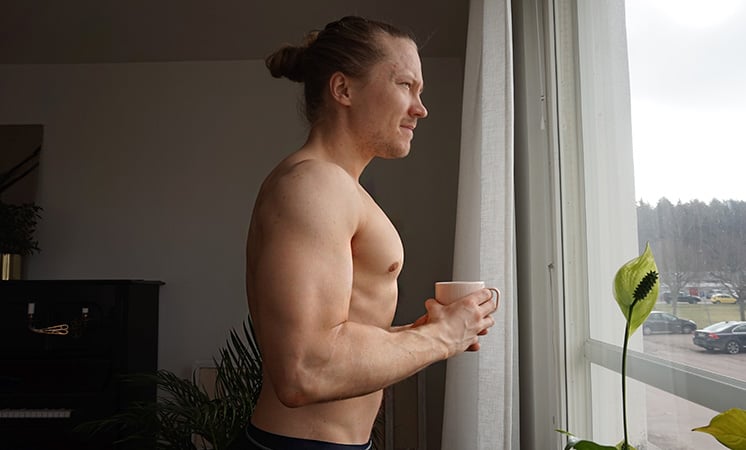
Coffee is always one of my go to sources to reduce hunger when I’m cutting. Research has shown that coffee increase levels of Peptide YY (PYY), which as I stated earlier is a fullness promoting hormone. According to Healthline this effect seems to be achieved even with decaffeinated coffee.
I’ve also found that coffee is very helpful in the morning during my fasted hours. The caffeine from coffee makes me want to move around and stay more active. This takes my mind off of food as well as increase fat burning hormones such as noradrenaline, adrenaline, cortisol and human growth hormone. These hormones not only helps burn stubborn fat, but also dampens hunger.
16. Eat on Smaller Plates
This is such a fascinating strategy. It seems so simple but it’s very effective. In my post “how to get ripped without counting calories and macros”, this was one of the strategies that makes getting lean without counting so much easier.
Why?
Well, because research has shown that it helps us feel fuller both on lesser food and longer after when we eat.
I actually tried this strategy out for myself for a week because I thought that it sounded bogus. Here’s the difference between the plate I used to eat from (on the right) and the plate I switched to (on the left):
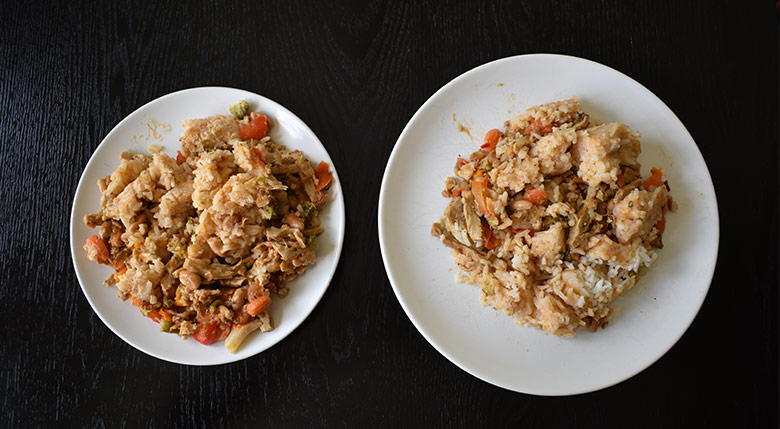
It’s the same amount of food on both of these plates, but to be completely honest it felt like I ate a lot more and also got fuller when I used the small plate instead of the big one. Fascinating to say the least.
17. Eat Using a Bigger Fork
This works in the same way as using smaller plates. By eating with bigger utensils you can dramatically affect how much food you need to feel full.
In this study they saw that participants who used bigger forks ate 10% less than those eating their meals with smaller forks. Supposedly this was the case because the people who ate using smaller forks felt that they didn’t make much progress in satiating their hunger, leading them to eat more.
Eating with bigger forks I haven’t tried. But these kind of strategies sure provides evidence that our mind and how we perceive things can have a HUGE impact on how we feel and what results we get.
18. Consume Omega-3 Fats
Consuming omega-3 fats has been shown to increase levels of the fullness hormone leptin.
Not only that, in this study researchers found that by consuming a diet rich in omega-3 participants felt fuller during a caloric restricted diet.
19. Find Your Inner Motivation

Let’s end this post with a deeper strategy.
During my 5 years in fitness I’ve come to realize that what makes me feel satiated and satisfied more than anything else is my mindset, or more specifically, the why behind what I’m doing.
In the beginning I was all about abs abs abs! I wanted nothing more than getting that ripped and muscular looking body. But, when I reached the goal I actually felt rather empty inside, like getting ripped didn’t mean that much to me, only chasing the illusion of abs did. This caused me to binge eat once I had become lean.
This was so frustrating that after I had my binge I researched why I didn’t feel happy when I finally achieved my goal and why I started to binge instead of just living with my awesome physique that I had built.
I found out that only wanting to look good externally is not going to fulfill me in the long-term. What will fulfill me is what getting ripped will do for me internally.
In order to feel good and be able to maintain my physique I needed to search for my deeper reasons behind why i wanted to become lean and muscular rather than just focusing on how I wanted to look. I wrote down a list of things that I felt would bring me joy and fulfillment internally.
Here’s that list of reasons why I actually want to get lean and muscular:
- To feel more confident around other people both in and out of my clothes.
- To challenge myself and build a resilient mindset. If I can achieve this I can achieve anything I set my mind to.
- To be able to stay between 10-15% body fat consistently forever because it’s healthy to be lean.
- So that I can help inspire others to feel more confident and sexy.
- So that I can build a business that can provide for me and my future family.
- To feel stronger in the gym.
- To feel more fit in general.
- To feel like I’m an expert on something.
- To develop my patience.
- To increase life expectancy.
- To sleep better.
- To look younger.
- Have a reputation for being fit.
- Get thank you email from people I’ve helped.
I always find new reasons that I add to this list as well.
Now, I suggest that you create your own list for why you truly want to get lean and muscular deep down inside. Because trust me, if you believe that getting lean and muscular is enjoyable and truly valuable to you deep inside, then hunger and dissatisfaction won’t be a problem anymore. Especially not if you adopt all the other strategies from this list on top your winning mindset.
I recommend that you place this list somewhere where you can see it on a daily basis. Then if/when the going gets tough, just read through your list and remind yourself of why you’re doing that you’re doing. I ensure you that this will help you get lean and ripped way more easily, and more importantly you will become fulfilled and ready to maintain your physique once you get it.
What’s Next?
By adopting these 19 strategies outlined in this article, hunger won’t stand a chance against you as you work your way to a lean and muscular body!
Now, if you don’t know where to get started when it comes to setting up your diet and training, then I recommend reading my completely free guide: How to Build The Hollywood Actor Type Physique. In the guide I teach you what to do depending on both your starting point and your goal physique.
You can get the guide for free here!

This is one lovely read! I appreciate your post. More power to you!
Thanks! Glad you liked it 🙂